Developed on American ranches, Australian Shepherds are hardworking and intelligent dogs that are happiest when given tasks and work to accomplish. Almost everyone has heard of Australian Shepherds — or at least seen one — because of the dog breed’s heavy involvement in rodeos and horse shows after World War II.
When a cowboy falls off a bucking bronco or uncontrollable bull, Australian Shepherds are there to herd the disgruntled animal away from the fallen entertainer. You can also catch Australian Shepherds messing with rodeo clowns during intermission performances. While they also make great family pets, Australian Shepherds need an active and seasoned owner that won’t let them get away with their tricks.
Australian Shepherd Characteristics (Physical)
With strong herding and guarding instincts, the Australian Shepherd breed has a body built for stamina. They are a balance of solid and muscular mixed with lithe and agile, making them a sturdy and solid medium-sized dog with matching bone density.
Australian Shepherds stand out because of their medium-length coat, often black, blue merle, or red merle. Australian Shepherds with merle coat patterns often have striking blue eyes or amber eyes — or even one blue eye and one brown eye. Their coat is double-layer, giving it a wavy or curly texture. To add to their characteristics, the Aussie also has short ears that flop over playfully and a naturally long tail that’s sometimes docked.
Australian Shepherd Size
This herding dog breed is considered to be medium-sized. It stands between 18 and 23 inches tall and usually weighs around 40 to 65 pounds. According to the American Kennel Club standards, an Australian Shepherd’s “quality should not be sacrificed in favor of size.”
Australian Shepherd Personality
This shepherd dog is highly intelligent and thrives when they have tasks and duties. They are known to herd just about anything, from cattle, to sheep, to children and ducks. Despite their seemingly endless energy, Australian Shepherds are very relaxed and laid back when it comes down to it. They're able to get along with other dogs and family members quite easily.
Still, Aussies are active dogs that prefer to stay busy. They can become destructive when left alone or confined for too long. This makes them most suitable for country living — or at least at a home with a large fenced in yard.
While they are known as quite lovable pets, Australian Shepherds are also great guard dogs, since they are protective of their family and territory. They will alert you when a stranger approaches, but are not known to be naturally aggressive.
Australian Shepherd Exercise
As you might have guessed, Australian Shepherds absolutely need exercise - and lots of it! They are happiest with families that are extremely active, meaning they will need some high-energy activities on top of their walks each day. This can be agility training or throwing a frisbee, which also gives these feisty dogs a job or goal as well.
Agility training includes jumping over hurdles, running over ramps or inclines, and racing through tunnels. There’s a reason that an Australian Shepherd, called Holster, won the Masters Agility Championship at the Westminster Kennel Club in 2016.
When Aussies aren’t stimulated with exercise and training, they can become destructive and loud. They're also known for barking for extended periods of time if they're bored.
Australian Shepherd Training
The Australian Shepherd breed is eager to please their owners, making them quite easy to train. You must first spend a lot of time with your Australian Shepherd puppy, ensuring you are building up trust and a solid bond early. They will become willing students who respond best to positive reward-based training methods.
One important thing to keep in mind when training your Aussie puppy is socialization. This will help you not only build a closer bond with your pet but stimulate their five senses, conditioning them to a multitude of situations early on. As such, it will help your Australian Shepherd focus more on the training at hand.
Australian Shepherd puppies are known to be a bit destructive thanks to their obsessive chewing. This can include expensive household items or even your hand. This bad habit is something you’ll want to address early on through chew toy training and bite inhibition. A puppy nipping your hand may be cute at first, but it won't be so adorable when they grow a bit older. And even if you are okay with a bit of roughhousing, this could scare or intimidate guests who aren't so comfortable with dogs that nip.
Australian Shepherd History
This dog breed is thought to have originated on American ranches. The Aussie's ancestors may include Spanish herding dogs that were brought to the United States along with Merino sheep herds back in the early colonial days. Collies may be one of their ancestors as well.
This shepherd breed was developed mostly in the western states starting in the 19th and 20th centuries. They were particularly favored by ranchers in Boulder, Colorado since they made great sheepherders up in the Rocky Mountains, seemingly unaffected by the altitude.
They are hardy breeds that don't mind rough temperatures and conditions. Since they originated in the United States, their name is a bit confusing. Even more confusing, it wasn't the first name this breed was given. They were once called Spanish Shepherds, Pastor Dogs, Bob-Tails, California Shepherds, and New Mexican Shepherds.
The breed got the name “Australian Shepherd” only because of the Australian Basque shepherds that came to the states in the 1800s. Today, Aussies work as herding animals, police dogs, and obedience competitors thanks to their willingness to work and their intelligent nature.
Australian Shepherd Health Problems
Aussies are relatively healthy dog breeds that often live up to around 13-years-old. There are a couple of common conditions and problems specific to the Australian Shepherd breed. Though, most can be prevented, treated, and managed if you make sure you regularly take your dog to get routine checkups.
Hip Issues
When it comes to breed-specific health problems, hip issues is another common problem for Australian Shepherds. This is a genetic condition that leads to a malformation of a dog’s hip socket. Over time, this can lead to joint problems and excruciating discomfort for your pup.
Some dogs can even go lame if left untreated, meaning regular X-rays and vet visits as your Aussie ages may be required. If your Aussie has joint or mobility issues, try our joint and mobility CBD dog treats, which provide extra comfort to your pets when they need it most.
Digestive Problems
Dogs, including Aussies, have a pretty hardy digestive system. But there are a few things you can do to avoid problems like loss of appetite and constipation. Of course, you’ll want to give them quality dog food with the right balance of nutrients. You should also avoid adding “human food” to their diets, especially processed foods. Give your dog a regular feeding time and a consistent feeding schedule to give them some regularity.
How to Care for an Australian Shepherd
Australian Shepherds require a lot of attention and playtime. They are best suited for a family who has that extra time to spend with them since they can become distressed and destructive when left alone for too long.
They also thrive with a dominant owner who has a lot of prior dog training experience, since they love to be given tasks. If you’re a newer owner, enroll in an obedience school for both of your benefits. Aussies should also be kept on leashes when taken for a walk or hike. They are known to stray and can be difficult to catch. Always make sure they consistently have freshwater, tons of toys for stimulation, and the proper amount of food.
Chew Toys
Aussie puppies love to chew. Encouraging them to gnaw on some chew toys instead is a great way to kick them out of this destructive — and sometimes painful — habit. Australian Shepherds also need extremely durable toys, like the Kong Extreme, since they do have a love of chewing and rough play.
Puzzle Toys
Toys that force your Australian Shepherd to solve problems or figure out how to get to their dog treats are popular with herding breeds. These smart dogs love a challenge and love to take on tasks that test their intelligence. It’s a great way to keep them occupied indoors.
Exercise Toys
Frisbees and balls for fetching and ropes for tug-of-war play are very important for Australian Shepherds. You will see a reduction in bad behavior when Aussies are given a chance to play around outside, especially if there’s a purpose involved.
Take Australian Shepherds in for regular vet visits and checkups to ensure they are healthy. A lot of times, dogs won’t act hurt or in pain even if they are, making it difficult to know if they’re developing any issues.
Nutrition and Feeding for Australian Shepherds
Like most dog breeds, Australian Shepherds should be fed quality organic dog food from trusted brands. Something to always keep an eye on is natural ingredients and a short ingredients list. Avoid dog food that has a lot of fillers and artificial additives, as well as by-products. In addition, Aussies have some specific requirements that set them apart from other breeds. The first is moderate-to-high fat content.
Due to Australian Shepherds’ energetic nature, they require higher fat content than the average dog, since it’s a source of their energy. Also make sure the food has low carbohydrate content, focused primarily on animal-based ingredients.
Coat Color And Grooming
Like other shepherd dogs, this breed only needs a shower every 3-4 months. If they happen to get filthy between washes you can bathe them but keep in mind bathing too often may lead to dry or irritated skin. With every wash, you will want to use a CBD dog shampoo that cleans as well as nourishes the skin and coat.
Australian Shepherds have a medium-length coat that can be straight, wavy, or a bit curly. There are multiple coat colors and patterns, including the aforementioned merle patterns that are most often associated with Aussies. This usually consists of blue or red fur blended with white and black, creating a unique speckle-like look. There are actually 16 coat patterns for Aussies, categorized by color and unique pattern.
Black Coat
Black Aussies have black fur in a saddle shape on their back and tail, as well as the back of their head. This is paired with some brown markings on the head and legs, and an otherwise white coat. Although, black Aussies can also just be bi-color, meaning just black and white.
Blue Merle Coat
There are multiple varieties of accepted blue merle coat patterns for Aussies. One is completely blue fur some black spots throughout the torso, another is similar but with some tan points on the feet and muzzle. Some Australian Shepherds with blue merle coats also have large areas of white fur, usually on the neck and chest area as well as the feet.
Red Coat
Aussies with red coats have similar patterns to Australian Shepherds with black coats. This means an Australian Shepherd can be fully red, red and tan, or red with white spots on the neck and chest. Some red coats are also tri-color, with white on the muzzle, neck, and chest along with some tan on the head and back legs.
Red Merle Coat
Similar to blue merle Aussies, red merle can be completely red with some black spots throughout the dog’s body. Or, red and black with some tan points on the feet and muzzle. There are also red merle Australian Shepherds with white on their neck, chest, and feet. Some red merle Aussies are red, white, and tan.
Since they have a double coat, you want to brush them as often as possible using a wire-pin or medium-bristle brush. This will help control the amount of shedding and prevent matting. If you can’t brush their coat once a day, weekly brushing is the next best thing.
You only need to bathe your Aussie when it's absolutely necessary. Too much bathing can leave their skin dry and irritated. When you do bathe them, always use a shampoo specifically made for dogs along with lukewarm water.
You can also trim the fur on the bottom of your dog’s feet to prevent matting between their toes. About once every six to eight weeks, use a pair of straight shears to cut the fur even with their pads. You can get help from a groomer if needed.
Children And Other Pets
Aussies are loyal family members who love children and other pets, especially if it means more playing and more attention. Of course, you will have to do a lot of socialization when your Australian Shepherd is a puppy! This is to ensure that they are used to having other animals and humans around them.
Australian Shepherds are even known to herd children while playing outside, which can be quite amusing. But sometimes this can lead to Aussies nipping at children’s heels. This can be avoided with proper training.
While Australian Shepherds are peaceful dogs, many Aussie owners recommend that they are supervised when with children due to their nipping and hyper behavior. They must also be around kids a lot throughout their life so they can learn how to properly behave around them with proper direction.
Try teaching your Aussie the “leave it” demand, which deters them from playing too aggressively with younger humans. You can also train your children, telling them the proper way to react when a shepherd gets a bit too feisty. Let them know that they should never run from the dog, which will only encourage Australian Shepherds to give chase.
Rescue Groups
There are a lot of Australian Shepherd rescue groups, including local ones you can look into:
- Aussie Placement & Rescue Hotline connects you with Aussies in need from every region in the United States.
- New Spirit 4 Aussie Rescue helps shepherds throughout North America.
- NorCal Aussie Rescue and Aussie Rescue SoCal provide homes for Australian Shepherds in California.
Always remember to check your local pet shelters and dog rescue groups for Australian Shepherds in your area. You can also look into websites like Adopt a Pet in your initial search to find shelters and dogs in need.
Breed Organizations
According to the AKC, the Australian Shepherd is the 17th most popular dog in the United States. Because of its rising popularity, there are a number of breed organizations for Aussies which inlude:
- Australian Shepherd Club of America
- The United States Australian Shepherd Organization
- Australian Shepherd Association
The purpose of breed clubs or associations is to unite Australian Shepherd owners with others in their community or around the world. Many will also provide information about the breed standard and help you decide if the dog is right for you. There are also competitive programs and events, which can center around looks and standards or agility and training. You can also check out the AKC to find AKC-registered breeders.
More About This Dog Breed
If you’re looking for help on the farm, an energetic companion for your children, or a running buddy, the Australian Shepherd is the perfect breed for you. They are lively and intelligent dogs with a good temperament and a willingness to be trained. This has also made them popular movie stars and rodeo performers. Many Australian Shepherds have also placed in agility competitions due to their speed and quick learning.
One Aussie even won a Frisbee competition in the 1970s. His name was Hyper Hank! He completely dominated the Frisbee scene, leading to a performance at the Super Bowl and later the White House. Another stand-out feature is the Aussie’s merle coat and eyes. Sometimes they are multi-colored. There are rumors that Native Americans once called Aussies “ghost eye” and considered them sacred because of their sometimes pale blue eyes. Beautiful, lovable, and intelligent, Australian Shepherds continue to become more and more popular pets. Find out more about Holistapet.
Continue Learning: Boston Terrier: Full Breed Guide & Everything You Need To Know!

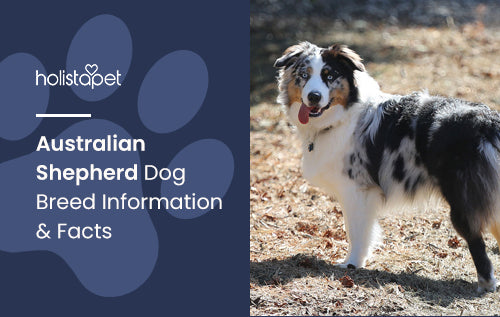
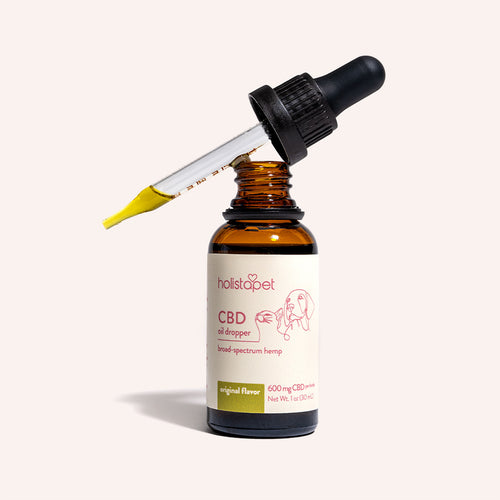 CBD Oil for Dogs - Fast Acting
CBD Oil for Dogs - Fast Acting
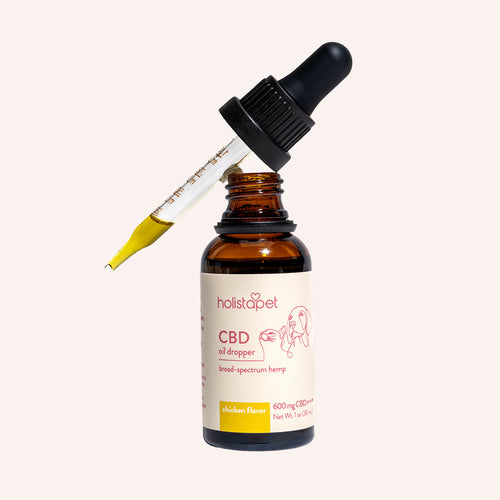 Chicken Flavored CBD Oil For Dogs - Easy Dose
Chicken Flavored CBD Oil For Dogs - Easy Dose
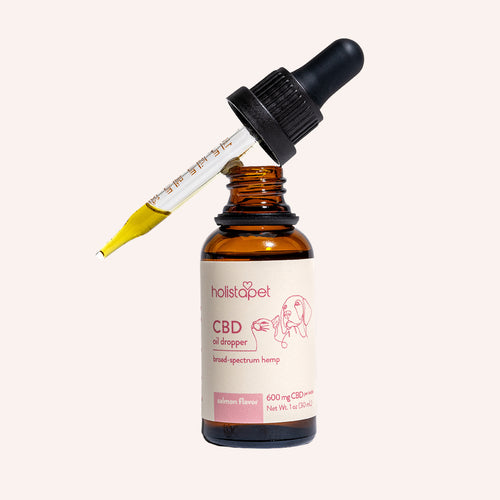 Salmon Flavored CBD Oil For Dogs - Highly Rated
Salmon Flavored CBD Oil For Dogs - Highly Rated
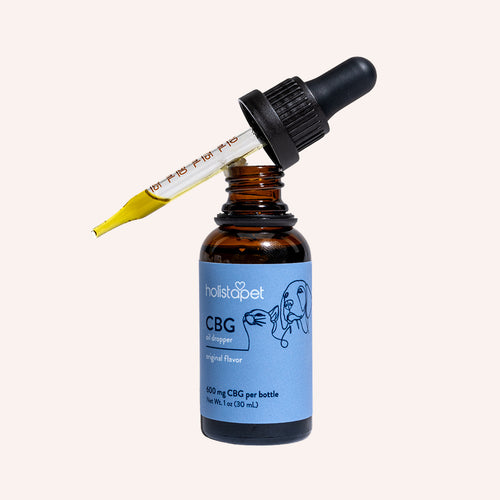 CBG Oil for Dogs and Cats - Loved by Thousands
CBG Oil for Dogs and Cats - Loved by Thousands


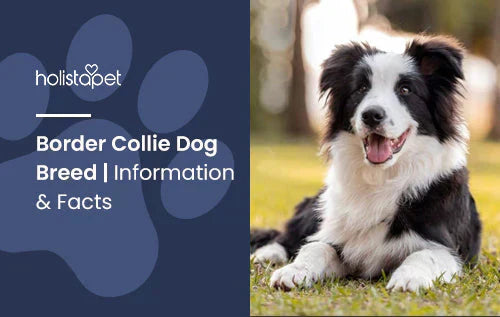
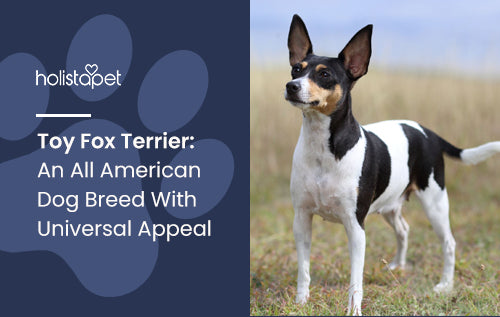

Leave a comment
All comments are moderated before being published.
This site is protected by hCaptcha and the hCaptcha Privacy Policy and Terms of Service apply.